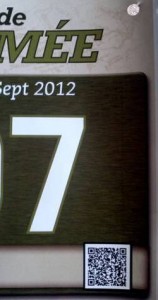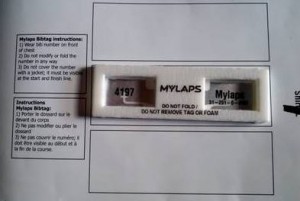 Found a great use of QR codes this weekend. It was while watching a race. I had no idea how technologically advanced the running world was, outside of the technology involved in producing running shoes.
Found a great use of QR codes this weekend. It was while watching a race. I had no idea how technologically advanced the running world was, outside of the technology involved in producing running shoes.
The race bibs all had distinct RFIDs on them in order to accurately keep track of each runners time, to the millisecond. The race computers track the start time of the race along with the time the runner crosses the start and finish lines. Yes the start line. With larger races where there are thousands of runners it takes a few minutes to even reach the start line.
Now the QR code portion. Each race bib, along with a unique number for each racer, has a QR code on it. When scanned it takes racer to a website showing their time, overall placement and other interesting statistics. It’s quick and easy for the racers to find out how they did overall.
 If we expand this use and look at other uses for QR codes where people may want to trace the amount of time it took for things to get to them than we can really get creative.
If we expand this use and look at other uses for QR codes where people may want to trace the amount of time it took for things to get to them than we can really get creative.
Perhaps as an addition to the food labels provided on food that is sold. And rather than sending customers to one general website for everyone, the package contains a QR code with information regarding the product that is in that particular package. For example, on a package of milk it could send users to a site where they know the area the cows that were milked are from and the date range. Or for each individual ingredient in packaged food – where it’s from, if that ingredient came into contact with egg, wheat or peanuts. The even more basic use of QR codes on food could be to take you to a web site with recipes with the product in it (taken one more step forward – with foods that are in season in your region, based on your GPS location).
In terms of retail, in clothing stores, have a QR code for each item in the store which takes you to a website that offers suggestions for coordinating with that product (and if your size is available in the store – for even more functionality – this part would involve more integration with backend systems and would be more costly). For example, I bought a pair of pants and either in the store or when I got home wanted to find out if there is a matching jacket I check out the QR code and it takes me directly to the site that shows coordinating outfits (which I can then click and buy or get the clerk to bring if the customer is still in the store). This is simple and inexpensive to do since price tags generally only have information on one side of the tag. The only addition retailers would need to do, if they already don’t have it is to have a page with coordinated outfits. Retailers are focusing on getting more people into their stores, and while they’re in there, getting customers to pay more. There is currently work being done on the mobile front and sending out offers to existing customers; however, this is a simple way of upselling to those in the store with minimal effort. The bar code is for the store and the QR code is for the customer.
QR codes still have a ways to go in being fully utilized. Are you using them in your industry and could you be expanding their use even more?
Related articles
- Using QR Codes to Preserve Identity (wired.com)
- Living Walletless, Week One: My Kingdom for a Bagel (wired.com)
- IKEA catalogue goes digital with ‘augmented reality’ (theglobeandmail.com)